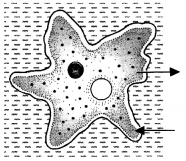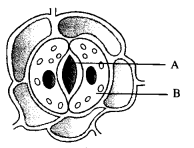HOTS Questions for Class 10 Science Chapter 6 Life Processes
These Solutions are part of HOTS Questions for Class 10 Science. Here we have given HOTS Questions for Class 10 Science Chapter 6 Life Processes
Question 1.
What does the diagram depict ?

Answer:
Gaseous exchange in Amoeba.
More Resources
- HOTS Questions for Class 10 Science
- NCERT Solutions for Class 10 Science
- Value Based Questions in Science for Class 10
- NCERT Exemplar Solutions for Class 10 Science
- Previous Year Question Papers for CBSE Class 10 Science
Question 2.
What does diagram depict ? What are A and B ?

Answer:
Double Circulation :
(A) Pulmonary Circulation
(B) Systemic Circulation.
Question 3.
How are viruses living when they do not show movements ?
Answer:
Viruses do not show movements outside the host cells. They show movements at the molecular level inside the living cells.
Question 4.
What is
(a) Primary reaction of photosynthesis
(b) Calvin cycle
(c) Krebs cycle
(d) EMP
(e) Oxidative phosphorylation ?
Answer:
(a) Primary Reaction of Photosynthesis: It is the conversion of light energy into chemical energy by chlorophyll a molecules.
(b) Calvin Cycle: It is a cycle of reactions that occur during reduction of CO2 to carbohydrate with the help of ATP and NADPH2 produced during light reaction.
(c) Krebs Cycle: It is a cycle of reactions that occur inside the mitochondria wherein an activated acetyl group is completely oxidised to form CO2, NADH2 and FADH2.
(d) EMP: Embden-Meyerhoff-Parnas pathway, also called glycolysis, is the first step of respiratory breakdown of glucose that occurs in the cytoplasm forming two molecules each of pyruvate, ATP and NADH2.
(e) Oxidative Phosphorylation: It is the process of ATP formation from ADP and inorganic phosphate with the help of energy liberated during oxidation of reduced coenzymes (NADH2, FADH2).
Question 5.
A girdled tree dies if the girdle is wide and is not filled up. Comment.
Answer:
Girdling removes bark containing phloem from the trunk region. Food manufactured by foliage does not reach the roots which requires the same as they are always growing. In the absence of food supply, roots starve and stop absorbing water. The foliage wilts and the plant dies.
Question 6.
Study the diagram. Name the parts “A” and “B”. State one function of each. (CBSE A.I. 2008)

Answer:
A—Stomatal pore or stoma Function: Pathway for exchange of gases or photosymthesis and respiration and loss of water vapours in transpiration.
B—Guard cell Function: Two guard cells present in each stoma, create pore when they are turgid and close the same when they are flaccid.
Question 7.
In the experiment “Light is essential for photosynthesis” why does the uncovered part of the leaf turn blue-black after putting iodine solution. (CBSE Foreign 2010)
Answer:
The uncovered part of the leaf exposed to sunlight performs photosynthesis and accumulates starch. Iodine reacts.with starch to give blue-black colouration.
Question 8.
Give one reason why multicellular organisms require special organs for exchange of gases between their body and their environment. (CBSE A.I. 2010)
Answer:
Multicellular organisms require special organs for exchange of gases as most of their cells are internal and are not in direct contact with environment.
Question 9.
Name the green dot like structures in some cells observed by a student when a leaf peel was viewed under a microscope. What is the green colour due to ? (CBSE Delhi 2010)
Answer:
Chloroplasts with green colour due to chlorophyll.
Question 10.
Explain the process of breakdown of glucose in a cell
- In the presence of oxygen
- In the absence of oxygen. (CBSE foreign 2010)
Answer:
Glucose is first broken down to pyruvic acid during glycolysis. Glycolysis occurs in cell cytoplasm. It produces energy.
- Presence of Oxygen: It is aerobic respiration where pyruvic acid is completely oxidised to carbon dioxide and water inside mitochondria releasing a lot of energy.
- Absence of Oxygen: Pyruvic acid is metabolised anaerobically in the cell cytoplasm forming either
- Ethyl alcohol (ethanol) and carbon dioxide or
- lactic acid: Very little energy is released.
Question 11.
Explain the process of digestion of food in mouth, stomach and small intestine in human body. (CBSE Delhi 2010)
Answer:
Mouth: Food is moistened, crushed and acted upon by salivary amylase which converts some starch into maltose and dextrins.
Stomach: Food is acidified, churned and mixed with enzyme pepsin. Pepsin acts in acidic medium over proteins to form soluble components, peptones and proteoses. Small quantities of semi-liquified food called chyme is passed on the duodenum.
Small Intestine: Acidity is neutralised and the food is made alkaline. Food is acted upon by pancreatic juice and succus entericus. Pancreatic juice has trypsin, amylase and lipase enzymes to digest proteins, carbohydrates and fats respectively. Succus entericus has enzymes for breakdown of peptides and disaccharides into amino acids and monosaccharides respectively.
Hope given HOTS Questions for Class 10 Science Chapter 6 Life Processes are helpful to complete your science homework.
If you have any doubts, please comment below. Learn Insta try to provide online science tutoring for you.